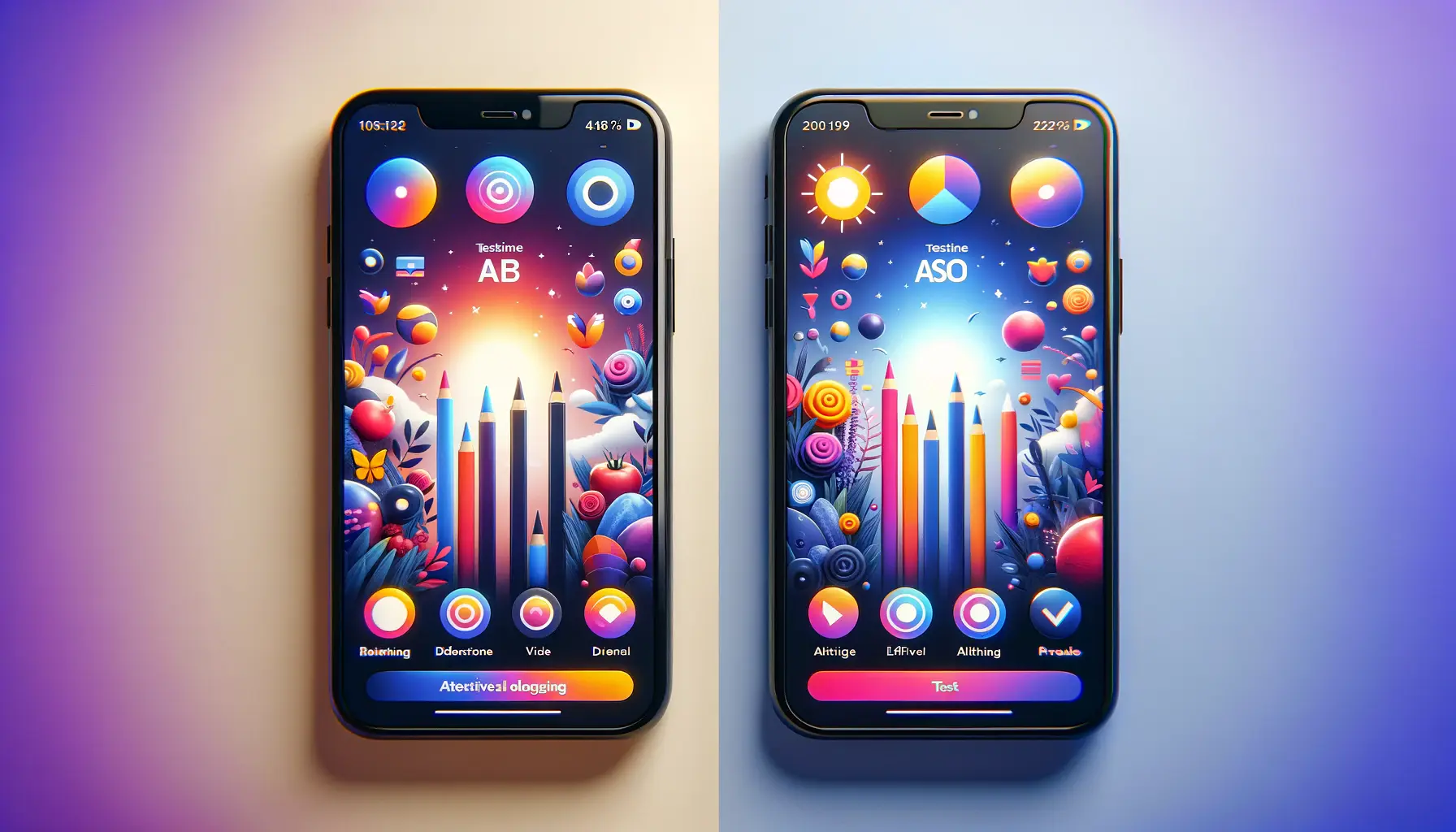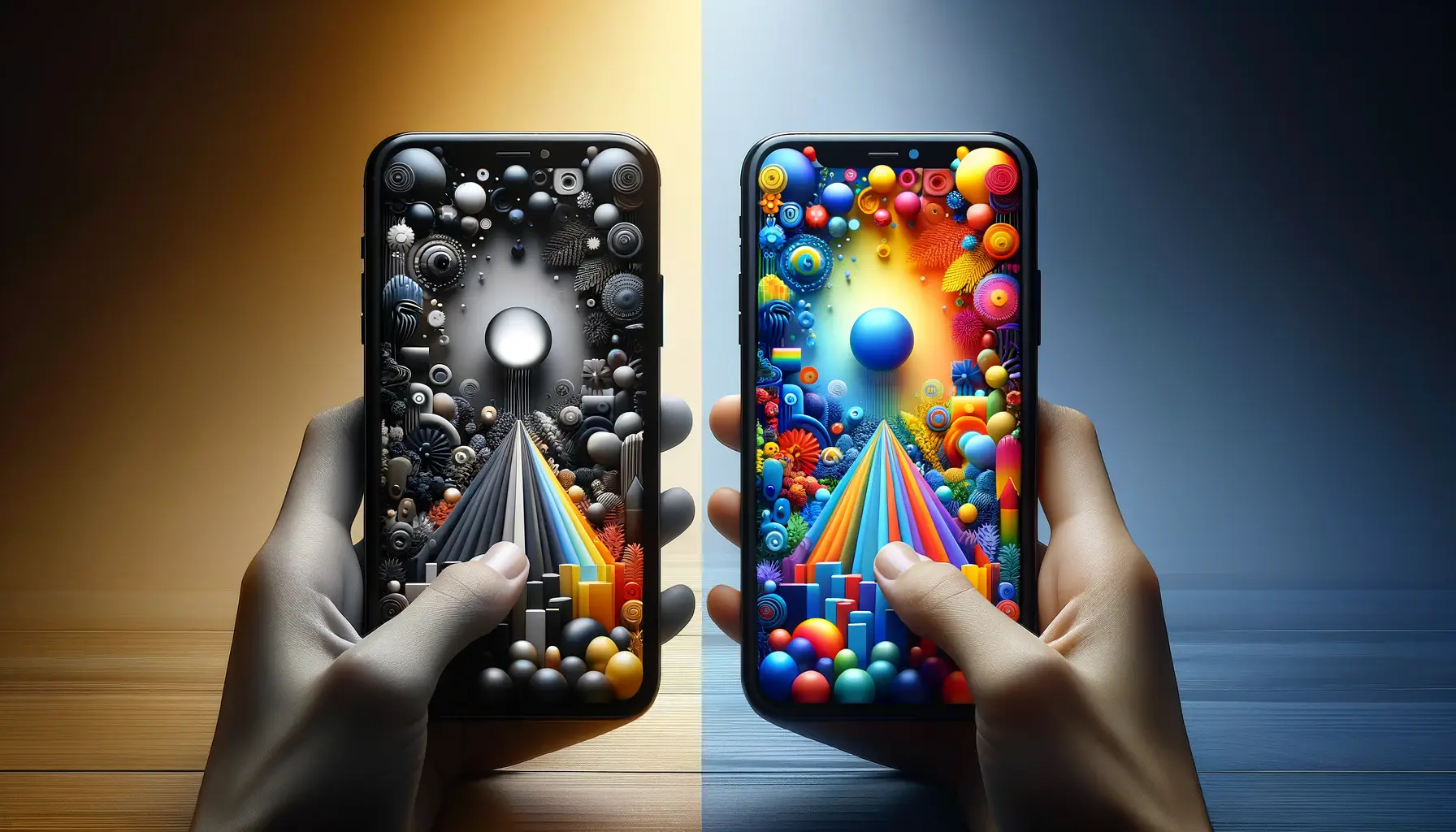In the ever-evolving landscape of app store optimization (ASO), A/B testing has emerged as a pivotal strategy for developers and marketers aiming to enhance the performance of their app listings.
At its core, A/B testing in ASO allows for a systematic comparison between two or more versions of an app’s screenshots to determine which iteration resonates best with the target audience.
This process not only aids in optimizing the visual appeal of an app but also plays a crucial role in improving its visibility and conversion rate within app stores.
The significance of ASO screenshots cannot be overstated.
They serve as a visual handshake between the app and its potential users, offering a sneak peek into what the app has to offer.
With the right set of screenshots, an app can effectively communicate its value proposition, capture the user’s attention, and ultimately, drive more installations.
This underscores the importance of employing A/B testing to meticulously refine these visual assets, ensuring they are perfectly aligned with the expectations and preferences of the target market.
- The Foundations of A/B Testing in ASO
- Strategic Implementation of A/B Testing
- Challenges and Solutions in A/B Testing
- Advanced Techniques in A/B Testing
- Integrating User Feedback into A/B Testing
- Leveraging A/B Testing Insights for Broader ASO Strategy
- Future Directions in ASO and A/B Testing
- Empowering App Success through A/B Testing in ASO
- A/B Testing for ASO Screenshots: Your Questions Answered
The Foundations of A/B Testing in ASO
Understanding A/B Testing
A/B testing, also known as split testing, involves presenting two variations of app screenshots to different segments of the app store’s audience to gauge which version performs better in terms of user engagement and conversion rates.
This methodological approach provides empirical evidence on user preferences, enabling app developers to make informed decisions regarding their ASO strategies.
By implementing A/B testing, developers can pinpoint specific elements within their screenshots that appeal most to their audience, such as the use of certain colors, layout arrangements, featured app functionalities, or even the inclusion of in-app characters.
This level of insight is invaluable for optimizing an app’s presentation in a crowded marketplace, where standing out from the competition is paramount.
Key Benefits of A/B Testing for ASO Screenshots
A/B testing for ASO screenshots delivers several tangible benefits, including improved user engagement, higher conversion rates, and enhanced overall app store performance.
By understanding which screenshot variations drive more downloads, developers can strategically refine their app listings to attract a larger user base.
Moreover, A/B testing facilitates a deeper understanding of the target audience’s behavior and preferences.
This insight allows developers to tailor their marketing and development efforts more effectively, ensuring that the app and its promotional materials are perfectly aligned with user expectations.
Additionally, A/B testing helps in minimizing the guesswork involved in ASO, providing a data-driven approach to visual optimization.
A/B testing is a critical tool in the ASO arsenal, offering a pathway to directly measure the impact of different screenshot variations on an app’s market performance.
Strategic Implementation of A/B Testing
Successfully implementing A/B testing for ASO screenshots requires a strategic approach, encompassing the careful planning of tests, meticulous execution, and thorough analysis of results.
This section outlines the step-by-step process that developers and marketers should follow to maximize the benefits of A/B testing in refining their app’s visual presentation.
Planning Your A/B Tests
Effective A/B testing begins with meticulous planning.
Key considerations include:
- Objective Setting: Clearly define what you aim to achieve with each A/B test, whether it’s increasing app installs, enhancing click-through rates, or improving visibility within app store search results.
- Variable Selection: Decide on the specific elements of your screenshots you wish to test. This could range from different layouts and color schemes to the inclusion of text overlays or call-to-action buttons.
- Audience Segmentation: Determine how you will segment your audience for the test. Segmentation can be based on demographics, user behavior, or device type, ensuring that the results are relevant and actionable.
Executing A/B Tests
The execution phase is critical in gathering accurate and meaningful data.
Consider the following steps:
- Variation Creation: Develop the different screenshot versions that you plan to test against each other. Ensure that each variation adheres to high-quality design standards and aligns with your app’s branding.
- Test Configuration: Set up your A/B tests within your chosen platform, specifying the duration of the test and the percentage of your audience that will see each variation.
- Monitoring Progress: Keep a close eye on the performance of each variation throughout the test duration. Monitoring tools and analytics platforms can provide real-time insights into how each version is performing.
Analyzing and Acting on Test Results
Once your A/B tests have concluded, the next step is to analyze the data and translate your findings into actionable insights.
Key actions include:
- Result Analysis: Examine the data collected from your A/B tests to identify which screenshot variation achieved the objectives set out at the planning stage.
- Understanding User Preferences: Delve deeper into the test results to gain insights into user preferences and behavior. This might reveal unexpected patterns or preferences that can inform future ASO and development strategies.
- Implementation: Based on your analysis, implement the winning screenshot variation in your app store listing. Consider also applying the insights gained to other aspects of your app’s presentation and marketing materials.
Continuous iteration and testing are the keys to refining ASO strategies. Each A/B test offers valuable lessons that can guide further optimization efforts.
Challenges and Solutions in A/B Testing
While A/B testing is a powerful tool for ASO, it comes with its own set of challenges.
Recognizing these challenges and employing strategic solutions is crucial for maximizing the effectiveness of your tests.
This segment explores common obstacles faced during A/B testing and provides practical solutions to overcome them.
Ensuring Statistical Significance
One of the primary challenges in A/B testing is ensuring that the results are statistically significant.
Statistical significance indicates that the observed differences between the variations are not due to chance.
- Solution: Use a larger sample size and extend the duration of your tests. Utilizing A/B testing tools that offer built-in statistical analysis can also help in determining when results are statistically significant.
Minimizing Bias
Another challenge is the potential for bias, which can skew your test results.
This can occur through premature conclusions or by testing too many variables at once.
- Solution: To minimize bias, clearly define your test conditions and stick to testing one variable at a time. Ensure that your audience segments are randomly selected to avoid any preconceived bias towards a particular variation.
Interpreting Results Correctly
Interpreting the data from A/B tests can sometimes be misleading, especially if there’s a misalignment between the test objectives and the metrics being measured.
- Solution: Align your test objectives with specific, measurable metrics. After the test, analyze both the quantitative data (such as conversion rates) and qualitative feedback (such as user reviews) to gain a comprehensive understanding of the results.
Adapting to Fast-Changing App Store Dynamics
The digital landscape and user preferences are constantly evolving, which can render previous A/B test results obsolete.
- Solution: Continuously monitor market trends and user feedback to stay ahead of changes. Regularly schedule A/B tests to ensure your ASO strategy remains effective and relevant.
While A/B testing in ASO presents several challenges, these can be effectively managed with careful planning, rigorous execution, and continuous learning.
Advanced Techniques in A/B Testing
As you become more familiar with the basics of A/B testing for ASO screenshots, incorporating advanced techniques can further refine your optimization efforts.
These strategies not only enhance the effectiveness of your tests but also provide deeper insights into user behavior and preferences.
Here, we explore some sophisticated approaches to elevate your A/B testing framework.
Segmented Testing
Segmented testing involves breaking down your test audience into smaller, more specific groups based on certain criteria, such as demographics, user behavior, or device type.
This approach allows for more granular analysis and understanding of how different segments of your audience react to your screenshots.
- Benefits: Segmented testing can uncover valuable insights that might be obscured in a broader test. For example, you may find that a certain screenshot variation performs exceptionally well with users from a specific region or age group.
- Implementation: Utilize analytics tools to segment your audience based on the criteria most relevant to your app. Run parallel A/B tests for each segment to compare the performance of screenshot variations.
Multi-Variable Testing
While traditional A/B testing focuses on changing one variable at a time, multi-variable testing (also known as multivariate testing) explores the impact of changing multiple variables simultaneously.
This method is more complex but can provide insights into how different elements interact with each other.
- Benefits: Multi-variable testing can significantly speed up the optimization process by testing multiple changes in one go. It’s particularly useful when you’re looking to optimize a combination of elements, such as screenshot layout, color scheme, and text content.
- Considerations: Ensure that your test audience is large enough to achieve statistical significance for multiple variables. Analyze the results carefully to identify which combinations of changes contribute to the desired outcomes.
Seasonal Testing
Apps often experience fluctuations in user engagement and downloads based on seasonal trends.
Seasonal testing involves tailoring your A/B tests to align with specific events or holidays to capitalize on these variations.
- Benefits: By optimizing your screenshots for seasonal trends, you can attract more users looking for apps that cater to their current interests or needs. This can lead to higher visibility and downloads during peak times.
- Implementation: Plan your A/B tests around upcoming holidays or events relevant to your app’s theme or functionality. Test screenshots that feature seasonal elements or promotions to gauge their impact on user engagement.
Incorporating advanced A/B testing techniques can significantly enhance your app’s visibility and user engagement by providing deeper insights into how different factors influence app store performance.
Integrating User Feedback into A/B Testing
While quantitative data from A/B testing provides valuable insights into user behavior, integrating qualitative user feedback can offer a more comprehensive understanding of how to optimize your app store presence.
User feedback sheds light on the reasons behind the behaviors observed in A/B tests, allowing for more informed decision-making.
This part explores strategies for collecting and incorporating user feedback into your A/B testing efforts for ASO screenshots.
Collecting User Feedback
Gathering user feedback is crucial for understanding the subjective experiences and preferences of your app’s users.
Effective methods for collecting feedback include in-app surveys, user interviews, and analyzing app store reviews.
Encourage users to share their thoughts on your app’s visuals and overall presentation, focusing specifically on the screenshots.
This can reveal insights into what users value in your app and any potential areas for improvement.
- Implementation: Implement in-app feedback mechanisms that prompt users to rate your screenshots or ask for specific feedback about your app’s visual appeal. Additionally, monitor and analyze reviews in the app store for comments related to your app’s screenshots and presentation.
Analyzing and Integrating Feedback
Once you have collected user feedback, the next step is to analyze the information and identify common themes or suggestions.
This analysis can uncover aspects of your screenshots that resonate well with users or areas that may be causing confusion or disinterest.
- Action Steps: Categorize feedback to identify patterns or commonalities among users’ responses. Look for insights that align with or contradict the results of your A/B tests. Use this information to refine your hypotheses for future A/B tests, focusing on enhancing aspects of your screenshots that users have positively highlighted or addressing any areas of concern.
Iterative Improvement Based on Feedback
The integration of user feedback into your A/B testing process should be iterative, with each cycle of feedback and testing informing subsequent optimizations.
This continuous loop of testing, feedback collection, and improvement ensures that your app’s screenshots remain aligned with user expectations and preferences, thereby enhancing your app’s appeal and conversion rate over time.
- Long-Term Strategy: Establish a systematic approach for regularly collecting and analyzing user feedback alongside ongoing A/B testing. This will help maintain the relevance and effectiveness of your ASO strategies in an ever-changing app marketplace.
User feedback is an invaluable asset in the A/B testing process, providing the context and insights necessary to refine and perfect your app’s ASO screenshots for maximum impact.
Leveraging A/B Testing Insights for Broader ASO Strategy
The insights garnered from A/B testing ASO screenshots extend beyond visual optimization.
They can serve as a cornerstone for refining your broader app store optimization strategy.
This holistic approach not only improves your app’s visual appeal but also enhances its overall marketability and user experience.
Here’s how you can leverage A/B testing insights to inform and improve your comprehensive ASO efforts.
Optimizing Metadata Based on A/B Testing Insights
The learnings from A/B testing can provide invaluable guidance for optimizing other elements of your app’s listing, such as the title, description, and keywords.
By understanding which visual elements resonate with your audience, you can infer their preferences and pain points, tailoring your app’s metadata to better reflect the value proposition that appeals to potential users.
- Application: If A/B testing reveals a preference for screenshots highlighting specific features or benefits, consider emphasizing these aspects in your app’s description and keywords. This creates a coherent narrative across your app’s listing that aligns with user interests and search behaviors.
Enhancing User Experience and Engagement
A/B testing insights can also inform the design and functionality of your app itself.
User preferences regarding screenshot layouts, colors, and content can reflect broader preferences that apply to the app’s user interface and experience.
- Implementation: Use insights from A/B testing to guide updates or changes within your app. For example, if users respond positively to screenshots featuring dark themes or specific in-app functionalities, consider how these preferences can be incorporated into the app’s design and feature set.
Influencing Marketing and Promotional Strategies
The effectiveness of different screenshot variations can also offer guidance for your broader marketing efforts, influencing everything from social media campaigns to email marketing content.
- Strategy Adaptation: Align your marketing materials with the themes, messaging, and visual styles that performed well in A/B tests. This ensures consistency across all touchpoints with potential users, reinforcing the app’s branding and value proposition.
Continuous Learning and Adaptation
Perhaps most importantly, A/B testing for ASO screenshots should be viewed as part of an ongoing process of learning and adaptation.
The app market is dynamic, with user preferences and competitive landscapes constantly evolving.
Insights gained from A/B testing should therefore inform not only immediate changes but also long-term strategy development.
- Long-Term Perspective: Regularly revisit and revise your ASO strategy based on fresh insights from ongoing A/B testing, market analysis, and user feedback. This iterative approach ensures your app remains competitive and continues to meet user needs effectively.
Integrating A/B testing insights into your broader ASO strategy enhances not just the app’s visibility but also its appeal and user experience, driving sustained growth and success in the app marketplace.
Future Directions in ASO and A/B Testing
The landscape of App Store Optimization (ASO) and A/B testing is continually evolving, driven by advancements in technology, changes in user behavior, and the dynamic nature of app marketplaces.
As we look towards the future, several trends and developments are poised to shape the direction of ASO strategies and A/B testing methodologies.
Understanding these potential shifts is crucial for app developers and marketers aiming to stay ahead of the curve and ensure the continued success of their apps.
AI and Machine Learning Enhancements
The integration of artificial intelligence (AI) and machine learning technologies into ASO and A/B testing tools is expected to significantly refine the process of optimizing app listings.
These technologies can analyze vast amounts of data more efficiently, providing deeper insights into user behavior and preferences.
Additionally, AI-driven predictive analytics could offer recommendations for A/B test variations, potentially increasing the likelihood of success.
- Impact: Enhanced predictive capabilities and more sophisticated analysis tools will enable developers to make more informed decisions, streamline the A/B testing process, and achieve better optimization results more quickly.
Increased Personalization
As app stores become more sophisticated, the ability to personalize app listings for different segments of the audience will likely become a key factor in ASO success.
Personalization can extend to customized screenshots, descriptions, and even app features presented to users based on their demographics, interests, and previous app usage patterns.
- Application: Leveraging user data to personalize the app store experience could significantly enhance user engagement and conversion rates, making A/B testing even more critical in identifying the most effective personalized elements.
Greater Emphasis on User Experience (UX)
The future of ASO and A/B testing will also see a greater emphasis on optimizing the overall user experience.
This means going beyond visual elements and metadata to consider how users interact with app listings and the app itself.
Factors such as app load times, ease of navigation within the app store, and the seamlessness of the installation process could become important considerations in A/B testing.
- Benefits: Focusing on the entire user journey from discovery to download and beyond can lead to higher retention rates and more positive reviews, further boosting ASO efforts.
Regulatory and Privacy Considerations
As digital privacy becomes a growing concern, future ASO and A/B testing efforts will need to navigate an increasingly complex regulatory landscape.
This may involve adapting strategies to comply with data protection laws while still effectively optimizing app listings and conducting meaningful A/B tests.
- Adaptation: Developers and marketers will need to be proactive in understanding and complying with privacy regulations, potentially leveraging anonymized data and ensuring user consent where necessary.
Staying informed about these future directions and proactively incorporating emerging trends and technologies into ASO and A/B testing strategies will be key to achieving and maintaining app success in the years to come.
Empowering App Success through A/B Testing in ASO
The journey through the intricacies of A/B testing in ASO underscores a pivotal shift towards data-driven strategies in enhancing app visibility and user engagement.
As we’ve navigated through the foundational concepts, strategic implementations, and advanced techniques, it’s clear that A/B testing is more than just a tool; it’s a compass guiding developers and marketers towards informed decisions that resonate deeply with their target audience.
Revolutionizing App Store Optimization
A/B testing for ASO screenshots has emerged as a cornerstone of modern app marketing strategies, enabling a deeper connection with potential users by showcasing an app’s features and functionalities in the most appealing light.
This meticulous process of testing, analyzing, and refining app visuals based on user preferences ensures that first impressions drive conversion, turning viewers into users.
Charting the Future of ASO
Looking ahead, the integration of artificial intelligence, increased personalization, and a heightened focus on user experience highlight the evolving landscape of ASO.
These advancements promise not only to refine A/B testing methodologies but also to elevate the app store experience for users and developers alike.
Amidst these changes, one thing remains constant: the necessity of embracing A/B testing as a fundamental element of a successful ASO strategy.
- AI and machine learning will offer unprecedented insights and predictive analytics, enhancing the precision of A/B tests.
- Personalization will tailor the app store experience to individual user preferences, increasing relevance and engagement.
- An emphasis on the comprehensive user experience will ensure that every touchpoint within the app store adds value to the user journey.
In conclusion, as the digital marketplace continues to evolve, so too must the strategies employed to capture and retain user attention.
A/B testing in ASO stands out as a vital practice in this regard, offering a pathway to not just visibility but meaningful engagement.
By harnessing the power of A/B testing, developers can navigate the competitive landscape of the app store with confidence, ensuring their app not only reaches its target audience but also delivers the value and experience that users seek.
Boost your mobile app's success with our guaranteed App Store Optimization (ASO) service. Leave it to the experts!
A/B Testing for ASO Screenshots: Your Questions Answered
Embarking on A/B testing for ASO screenshots can raise numerous questions. To help you navigate this process, we’ve compiled a list of frequently asked questions and their answers.
A/B testing in ASO involves comparing two versions of app screenshots to determine which performs better in attracting users.
It helps identify the most effective screenshots that can improve your app’s visibility and download rates in the app store.
Begin by defining your objectives, choose the screenshot variations to test, and use an A/B testing tool to run your experiment.
Yes, by optimizing screenshots based on A/B testing insights, you can increase your app’s appeal, enhancing download rates.
Focus on testing layout, color schemes, text presence, and the depiction of app features or benefits in your screenshots.
A/B tests should run long enough to gather significant data, typically 7-14 days, depending on your app’s traffic.
It’s best to test one element at a time to accurately measure its impact, though advanced techniques allow for multi-variable testing.
Compare the performance metrics, like click-through and conversion rates, of each variant to identify which version achieved your objectives.













nice and very well writen.
Thank you!